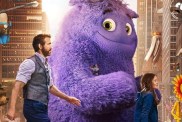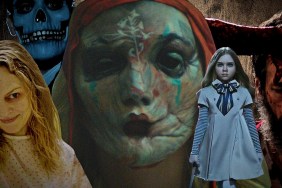
Filmmaker Mickey Keating’s deft fest hit is an indie horror landmark.
Its not what you have.
Its not the colors in the pallete.
Its not the gear.
Its not the tech.
Its not the government funding. Its not the marketing.
Art is none of these things.
No, art is simply the reflection of the artist, authentic and true and brave and bold and alive and visceral. Art is using whatever you have at your disposal to project the dreams and nightmares and hopes and fears and horrors and truths and fantasies you want to share in ways that are pure. In ways that are yours, unique to you.
Of course, when it comes to pushing the definition of art into the confines of an intensely commercial industry, some of that purity is bound to be lost. And so it goes with cinema. And if you truly love movies, this amalgam of all the liberal arts, you have to be forgiving, I think.
I know I have had to be. As a fan.
Especially in regards to a populist genre like horror, you have to navigate plenty of trend and soft-witted terrain to find the moments that transcend. And Im fine with that. I have long lived for moments. Life is like that. We endure and suffer and when the moments come, we remember. And we hold on to them.
But once in a while a horror film appears. A real deal, peel back the surface and see the slithering worm-life underneath horror movie. It comes not with a Michael Bay budget or major studio marketing campaign, but with a mandate to make a movie that matters; something alive and screaming, something dangerous.
Recently, I reviewed a no-budget piece of transgressive cinema masquerading as a horror film called UPSIDEDOWN CROSS and I bring it up now because it was one such film. UPSIDEDOWN CROSS is a picture I fear will get lost in the DIY DVD quagmire and I want to make sure more people see it. That film applied the principles of making a successful feature-length independent movie while also functioning as direct expression and statement of its maker, in this case, director William Hellfire.
The movie were chiefly here to discuss today, right now, is kin to that film in philosophy, but it’s more than a bit different in its presentation. Its an immaculate work of art and one of the most affecting horror movies Ive ever seen.

As you already know, that picture is director Mickey Keatings poisonous psychodrama DARLING, a movie that breaks rules and is filled with so much innovation and such daring, deceivingly simple vision, that I actually yelled out loud as it un-spooled, shouting in excitement and a joy stemming from the revelation that the people that made it were not only making an auteur horror movie that was progressive and meaningful, but that a third party was backing the movie, distributing it and ensuring that people saw the movie and knew it existed.
DARLING. Sweet, horrible, savage DARLING.
Imagine early incarnations of David Lynch, Roman Polanski, Lars von Trier and Guy Maddin on a three day meth bender in one of Stanley Kubricks suites at The Overlook Hotel and youll get a sense of DARLINGs mission statement. Made for very little money with a skeletal cast on spare locations (primarily a looming house in what I think might be upstate New York), DARLING casts the doe-eyed Lauren Ashley Carter (JUG FACE) as an obviously disturbed girl who accepts a position as the caretaker at posh mansion owned by an elegant, icy and presumably wealthy woman (BLADE RUNNERs Sean Young, looking great and a welcome presence back on the screen). Like Jack Nicholsons Jack Torrance at the aforementioned Overlook in Kubricks impossibly influential THE SHINING, its clear that Carter is crackers from frame one. But considering the homes haunted history, its a given that shell go even madder as the movie progresses. And she does.
My god, does she.

Filmed in stark black and white, an affectation that both glosses over any budgetary restraints while adding elegance, mystery and menace by flipping the mundane parameters of the natural, shot-on-video world into monochrome, the films visual sheen echoes one of the pictures closest stylistic cousins, that of Polanskis 1965 girl-gone-gaga melodrama REPULSION. Theres also a nod to either Woody Allen or von Trier in the way the picture is divided into chapters.
Carter is a magnificent presence and Keating knows exactly how to use her like a kind of living piece of mise-en-scene to move around his carefully controlled universe, allowing his camera to prowl after her on the streets, to stare at her from distances, to dive into her when she is most vulnerable physically and emotionally. Its one of the greatest master/muse cinematic marriages since Jonathan Glazers equally unforgettable UNDER THE SKIN.
And like that unsettling contemporary nouvelle vague sci-fi horror masterpiece, DARLING relies heavily on its sound design and music to batter its helpless audience senseless.
And like Mica Levis discordant soundscape in SKIN, Giona Ostinellis alarming score here is set to stun, amplifying simple sequences into the stuff of shrill horrorshow; every movement is accompanied by an off sting, a loud slam of percussion, an atonal screech.
The ultimate effect is like having the most hideous of hangovers, where every soft sound splits your skull open.

Of course, Ostinellis soundscape isnt all attack, theres some lovely piano passages and Jerry Goldsmith-influenced percussion pieces that are incredibly evolved, daring and unique. But Keating takes great pleasure in abusing them, thus abusing us, the audience. A section where Carter and her potential lover/victim have a conversation in the homes opulent dining room is murdered by Keatings choice to nearly drown out all traces of dialogue entirely, letting Ostinellis music swell to uncomfortable volumes, culminating in an act of violence which is the gory punchline to the unfunny joke.
And the movie is indeed gory.
One might say that because the film is black and white, the gore has a diminished effect, but thats not true at all. Like PSYCHOs chocolate sauce in the shower, the bloodletting in DARLING is a character, foreshadowed in quick, violent bursts throughout and wallowed in to near blackly comic levels toward the final quarter. And like the best horror films, the grue is simply the extension of the themes of the picture, in this case, the logical culmination of the lead anti-heroines simmering insanity.
DARLING is co-produced by the great Larry Fessenden, who also appears in the film, a product of his Glass Eye Pix, a company that almost always makes interesting, modestly budgeted and wholly original horror films.
But here, backing Keatings vision, they may have made their first real deal masterpiece.
DARLING is a perfect movie in its imperfection. Its a movie that bends rules and defies expectations and always remains a messy, personal primal scream of a picture. Its most assuredly a work of dark, seething art and, as the hyperbolic headline of this review screamed, its the best horror movie of 2016.
Well, so far, anyway.
But I cant imagine it will get any better than this.
Then again, I havent seen Keatings Sundance hit CARNAGE PARK yet
Look for DARLING when it opens theatrically in NYC this Friday, April 1st and then goes wider and hits VOD on April 8th.









